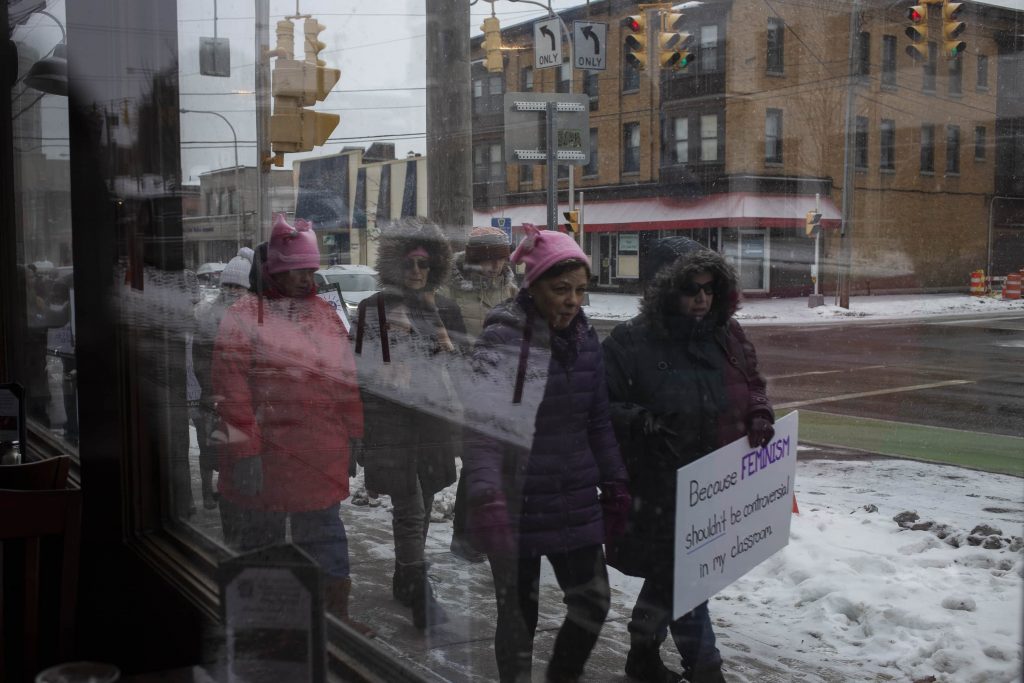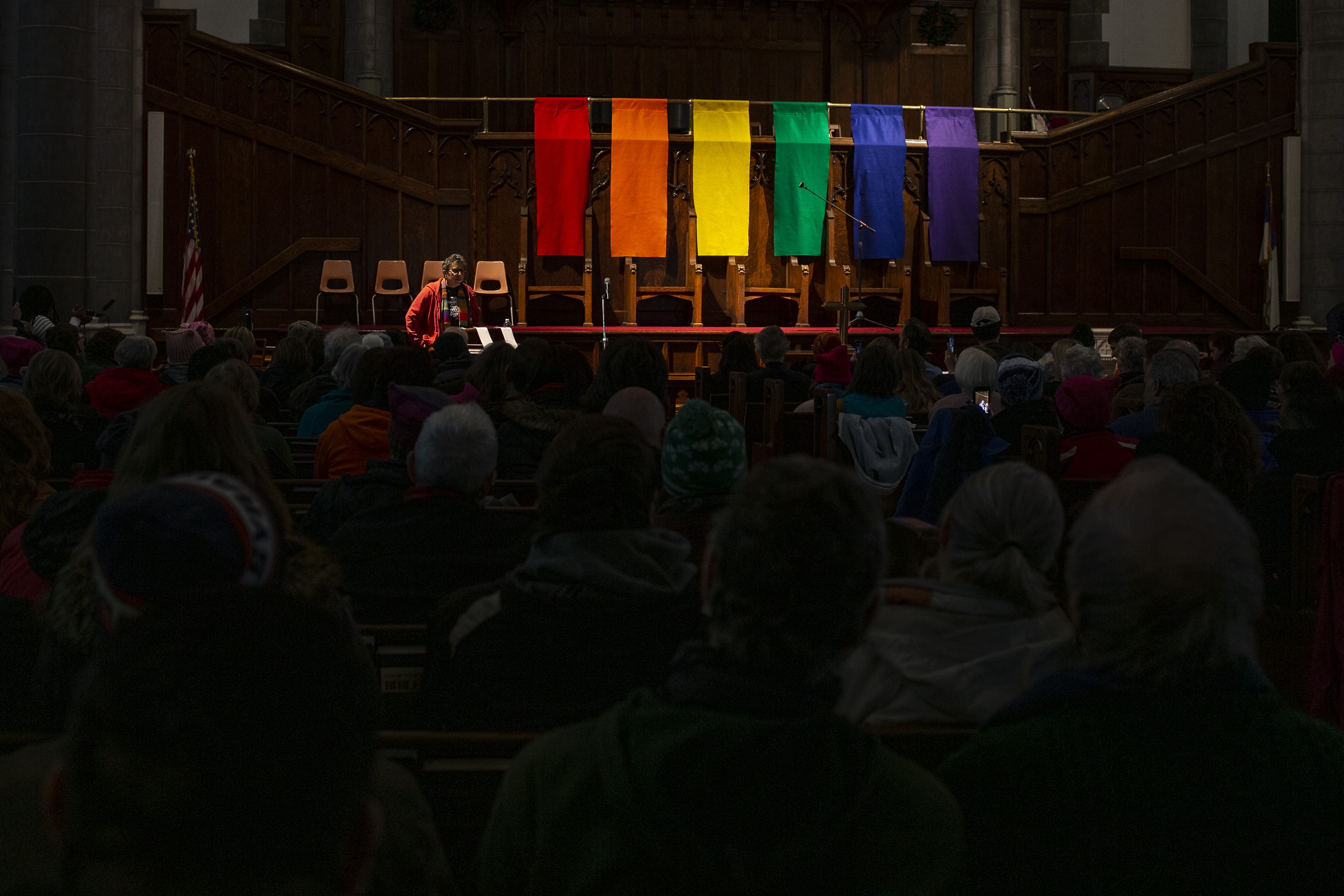2019 Syracuse Women’s March draws hundreds
Hundreds join 2019 Syracuse Women's March

“The whole point of this march is to reflect what is Syracuse and how it’s a diverse place for everyone,” Nada Odeh said to participants of the 2019 Women’s March in Syracuse. The crowd assembled filled nearly every pew of University United Methodist Church – the final rallying point for the group, which started marching from Everson Museum plaza at 10 a.m. in spite of low temperatures and an impending winter storm.
Approximately 700 residents walked the streets of Syracuse despite the heavy snowfall, chanting things like “When women’s rights are under attack – Stand up! Fight back!” People of all ages carried signs with witty quotes about the issues that mattered to them – including women’s health, the LGBTQ community, science and technology.
The leading sign read, “Women’s March Toward Intersectionality Syracuse 2019” which was the underlying message that Odeh wanted to convey. Odeh, who is originally from Syria, was one of the core organizers of the event. She said that the march reflected many issues, so she organized a diverse list of speakers to address the participants at the end of the route. Among these speakers were Serena “Rahzie” Seals and Kim Alexander of Black Lives Matter, Sen. Rachel May of New York’s 53rd District, and Khadijo Abdulkadir of New American Empowerment.
Although this march is not associated with the previous Women’s Marches that have taken place in Syracuse, Odeh said that it took very little time to put everything together on the first try. “We’re different,” she said. She created the Facebook event on January 4th and brought the organizers together to finalize plans in just two weeks.
A month ago, Odeh realized she had to take a stand. She believes that a problem in Syracuse is the city having 86 actively spoken languages because of the refugee and Native-American community, but the “major scenes” of Syracuse don’t reflect that kind of diversity.
“Because I’m coming from Syria, I come from the Middle East, I felt like I should be the one to start getting involved in everything that do not have enough representation,” Odeh said. “I never did such a thing before, I wondered what the consequences could be. We wanted to make sure everyone’s safe. We spent two days trying to find the right venue.”

Odeh said she was surprised to see the response that the event generated online. People were messaging her, asking how they could pitch in or volunteer for the march. The first thing she would ask was, “What can you do?” because that’s the most important thing, she said. “With social media, creating all these things is really easy, you know.”
Patricia Szlamczynski Stassi, one of the co-organizers of the march with Odeh, has been attending the Seneca Falls march for the past two years. “I realized that I actually live in a city that’s more integrated, so what can I do here to get that kind of a unification in my own city versus travelling to another city.”
She also noted that the women’s movement is about intersectionality. “The banner that Nada asked me to make at the beginning of the march has patchwork that includes or represents or symbolises many of the ‘marginalised groups’ that maybe feel excluded or invisible or not heard with an emphasis on intersectionality.”
Alexandra Sargent, administrative assistant at Syracuse University’s School of Information Studies, expressed her excitement about her first time walking for causes that she cares for. “With the government shutdown, Brett Kavanaugh put in a place of power, our climate – I felt hopeless and helpless,” Sargent said. “It’s nice to be doing something with people instead of just watching things anymore.”
Victoria Munley, a Visual and Performing Arts student at SU, carried a sign that read “Pretty is not the rent you pay to exist in the world as a woman” and said she believes that it is important for college students to voice their opinions.
The march ended at the University United Methodist Church around 11 a.m. with the same energy that it began with. Several vehicles that passed by honked and showed support for the event, which often resulted in an increase in the crowd’s enthusiastic chanting. After the participants made their way into the church, speakers began to share poetry, music and wisdom gleaned from personal experience.
While discussing Black Lives Matter, Rahzie asked the crowd to repeat “Trans women are women,” and noted that trans black women’s voices aren’t often heard until they are dead and asked everyone at the church to pay their respects to black transgender women who lost their lives in the past year.
The march ended after noon, with refreshments offered to all in attendance. Groups like the Community for the Grid, an advocate for the community grid to replace the I-81 viaduct in Syracuse, set up a table for residents to sign a petition and handed out postcards to participants as they left.
Later in the day, Odeh and the other participants expressed their gratitude on the Facebook event page, and continued to share photos from the event and messages of support.





